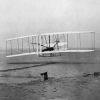Decennial Census Historical Facts
Decennial Census Historical Facts
Censuses are not conducted in a vacuum. They occur amidst internal and external crisis, shifts in cultural interests, and events that become "defining moments" for each decade. Census data reflect the growth of the population as well as the changing values and interests of the American people.
Decennial Historical Facts provides a portrait of the United States both statistically and culturally in the following four areas:
- Pop Culture – key milestones from the decade following the census.
- Population
- Census Details
- 10 Largest Urban Places
1900
ICONS: Wright Brothers, Pablo Picasso, Ford Model T



Population
| 76,212,168 | U.S. Resident Population |
| 21.5 |
Population per square mile of land area |
| 21.0 |
Percent increase of population from 1890 to 1900 |
| 45 |
Number of States |
10 Largest Urban Places
| Rank |
Place |
Population |
|---|---|---|
| 1 |
New York City, NY | 3,437,202 |
| 2 |
Chicago, IL | 1,698,575 |
| 3 |
Philadelphia, PA | 1,293,697 |
| 4 |
St. Louis, MO | 575,238 |
| 5 |
Boston, MA | 560,892 |
| 6 |
Baltimore, MD | 508,957 |
| 7 |
Cleveland, OH | 381,768 |
| 8 |
Buffalo, NY | 352,387 |
| 9 |
San Francisco, CA | 342,782 |
| 10 |
Cincinnati, OH | 325,902 |
The 1900 Census
| Cost | $11,854,000 |
| Cost per Capita (cents) | 15.5 |
| Total Pages in Published Reports | 10,925 |
| Number of Enumerators | 52,871 |
| Census Bureau Director | William Rush Merriam |
| Number of Questions on the Questionnaire | 28 |
| Number of Questions on the Long Form | N/A |
Pop Culture
- Kodak® introduces the "Brownie" camera in February 1900.
- On September 6, 1901, Leon Czolgosz shot President William McKinley. He died at 2:15 a.m. on September 14 and Vice-President Theodore Roosevelt was sworn in as president later that day.
- Composer and musician Scott Joplin publishes The Entertainer in 1902.
- The January 22, 1903, Hay-Herran Treaty grants the United States a renewable lease in perpetuity from Colombia on the land proposed for the Panama Canal.
- On February 14, 1903, the U.S. Census Bureau becomes part of the new U.S. Department of Commerce and Labor.
- The first silent film, The Great Train Robbery, debuts in 1903.
- Orville and Wilbur Wright are first to fly a controlled, powered, and sustained heavier-than-air airplane at Kitty Hawk, NC, on December 17, 1903.
- Prominent civil and women's rights leader Susan B. Anthony dies on March 13, 1906.
- The first underground portion of the New York City subway opens on October 27, 1904.
- At 5:12 a.m. on April 18, 1906, the "Great San Francisco Earthquake" strikes.
- Artist Pablo Picasso introduces Cubism in 1907.
- An explosion in West Virginia's Monongah Mine on December 6, 1907, becomes the nation's worst industrial disaster. The "official" number of deaths was 362 adult and child miners, but later estimates exceed 500.
- Henry Ford begins production of the Model T in 1908.
- The National Association for the Advancement of Colored People (NAACP) is founded on February 12, 1909.
- The U.S. Mint introduces the "Lincoln Head" penny in 1909.
Page Last Revised - October 8, 2021




